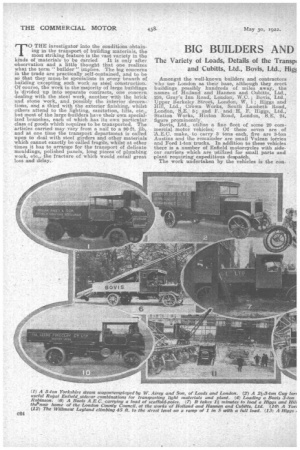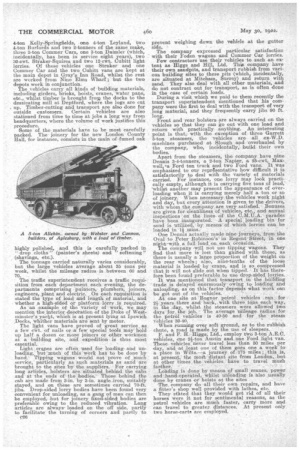BIG BUILDERS AND ROAD TRANSPORT.
Page 18

Page 19

Page 20

If you've noticed an error in this article please click here to report it so we can fix it.
The Variety of Loads, Details of the Tramp' • and Cubitts, Ltd., Bovis, Ltd., Higl d Methods Utilized by Holland and Hannen Ltd., and F. and H. F. Higgs, Ltd.
TO THE investigator into the modifier's obtaining in the transport. of building materials, the most striking feature is the vast variety in the
kinds of materials to be Carried It is only after observation and a little thought that one realizes what the term " builder " implies. The big concerns in the trade are practically self-contained, and to be so that they must be specialists in every branch of building excepting such work as steel construction. Of course, the work in the majority of large buildings is divided up into separate contracts, one concern dealing with the steel work, another with the brick and stone work, and possibly the interior decorations, and a third with the exterior finishing, whilst others attend to the lighting, sanitation, lifts, etc., but most of the large builders have their own specialized branches, each of which has its own particular class of goods which requires to be transported. The articles carried may vary from a nail to a 90-ft. jib, and at one time the transport department is called upon to deal with steel girders and other materials which cannot exactly be called fragile, whilst at other times it has to arrange for the transport of delicate mouldings, polished panels, long pieces of plumbing work, etc., the fracture of which would entail great loss and delay.::
Amongst the well-known builders and contractors who use London as their base, although they erect buildings possibly hundreds of miles away, the names of Holland and Hannen and Cabitts, Ltd., 258, Gray's Inn Road; London, W:C. ; Bovis, Ltd. Upper Berkeley Street, London, W. 1; Higgs and Hill, Ltd., Crown Works, South Lambeth Road, London, S.E. 8; and F. and H. F. Higgs, Ltd., Station -Works, Hinton Road, London, S.E. 24, figure prominently.
Bovis, Ltd., utilize a fine fleet of some 20 commercial motor vehicles: Of these seven are of A.E.C. make, to carry 3 tons each, five are 3-ton Austins and the remainder are small Vulcan lorries and Ford 1-ton trucks. In addition to these vehicles there is a number of Enfield motorcycles with sidecar carriers which are utilized for small parts and vlant requiring expeditious despatch. The work undertaken by the vehicles is the con veyance of plant and materials used in the trade, these including ladders, machinery, se,atfolding, bricks, joinery, paint, harelcore and rubbish. The whole system of operation is administered by a transport control office at the main yard of the company in East Row, E.O., this office being responsible for time-keeping and accurate supplies. At night all the vehicles are kept at Carmo, Ltd.'s garage in Hatton Street. Carmo, Ltd., is a subsidiary company to Bevis, Ltd., and were called into being by the huge demand for transport placed upon them by the parent company. From this beginning they have developed to actiYities ranging from tine supply of small accessories to complete service for the motoring public. They are responsible for the maintenance and overhauling of the Bovis fleet.
The area eovered by the vehicles is only limited by the distance at which the jobs in hand at any
moment are situated, and consequently trips are necessitated to distant towns in the country as occasion demands. The average lorry run over-a period of one year has worked out at 15 miles per diem, with an average petrol consumption of 6 m.p.g. for the A.E.C. vehicles, 10 m.p.g. for the Austnis and 12 m.p.g. and 15 m.p.g. respectively for the Vulcan and Ford machines. The sidecar machines average 45 m.p.g.
The method of loading and unloading depends upon the work in hand. Each yard is provided with a gantry and crane with loading tackle, and the big buildings to which the material and plant are delivered have electric derrick cranes which facilitate unloading and reduce time expenditure to a minimum. Each lorry is provided with a gantry or bolster positioned at the back of the driver's cab. This is for earr,ying long articles. The proved advantages of mechanical transport in comparison with horse-drawn vehicles is that greater quantities of material can be carried in one load in much less ‘time and for a considerably greater distance; furthermore, additional staff is not required for grooming, bedding-down, etc. The fleet employed by Holland and Hannen and Cubitts, Ltd., comprises four 5-ton Fodens, two 4-ton Kelly-Springfields, one 4-ton Leyland, two 4-ton Burfords and two 2-formers of the same make, three 3-ton Commer Cars, one 3-ton Daimler (which, incidentally, has been, in service eight years), two 30-cwt. Straker-Squires and two 12-cwt. Cubitt light lorries. Of these vehicles one Straker and one Commer Car and the two Cubitt vans are kept at the main depot in Gray's Inn Road, whilst the rest are worked from Nine Elms Wharf ; but the two depots work in conjunction. The vehicles carry all kinds of building materials, including girders bricks, hoists, cranes, water pans, etc., whilst timber is brought from the docks to the dessicating mill at Deptford, where the logs are cut , up. Timber-cutting and transport are also done for outside customers. Certain vehicles are also stationed from time to time at jobs a long way from headquarters, where the volume of work justifies this procedure. Some of the materials have to be most carefully packed. The joinery for the new London County Hall, for instance, consists in the main of fumed oak highly polished, and this is carefully packed in " drop cloths" (painter's sheets) and " softening" (shavings, etc.). The tonnage carried naturally varies considerably, but the large vehicles average about 35 tons per week, whilst the mileage radius is between 60 and 70.
The traffic superintendent receives a traffic requisition from each department each evening, the departments comprising 'painters,' plumbers, joiners, engineers, ,plant and electric. On each requisition is stated the type of load mid length of material, and
• whether a high-sided or platform lorry is required. As -an example of the variety of work, we may mention the interior decol•ation of the Duke of Westminster's yacbt, which is at present lying at Ipswich Docks, whither materials are sent by motor.
The light vans have proved of great service as a few cwt. of nails or .a few special tools may' hold up half a dozen or more joiners or other -workmen at a building site, and expedition is thus most essential.
Light cranes are often used for loading and unloading. but "much of this work has to 'be done by hand: Tipping wagons -would not prove of nuich service, particularly as such materials as sand are brought to the sites by the suppliers. For carrying long articles, bolsters are situated behind the cabs and at the ends' of the bodies; Those behind the cab are made from 3-in. by 3-in, angle iron, suitably stayed, and on these are sometimes carried 70-ft. jibs. Drop-sided lorry bodies have been found very convenient for unloading, as a gang of men can then be employed, but for joinery fixed.-sided bodies are preferable owing to the reduced vibration. Long articles are alwaysloaded on the off side, partly to facilitate the turning of corners and partly to
e26 prevent weighing down the vehicle at the gutter side.
The company expressed particular satisfaction with their Foden wagons and Com.mer Car lorries.
Few contractors use their vehicles to such an extent as Higgs and Hill, Ltd. Thiii company have their own sandpits' and transport rubbish from various building sites to these pits (which., incidentally, are situated at Mitcham, Surrey) and return with sand. They also deal with all other materials and do not contract out for transport, as is often 'done in the case of certain loads.
During a visit which we paid to them recently the transport superintendent mentioned that his company were the first to deal with the transport of very long material, and they frequently carry jibs 90 ft. long. Front and rear bolsters are always carried on the vehicles so that they can go out with one load and return with practically anything. An interesting point is that, with the exception of three Garrett 5-ton steamers, the vehicles are all ex-W.D. machines purchased at Slough and overhauled by the company, who, incidentally, build, their own bodies.
Apart from the steamers, the company have nine Dennis 3-4-tonners, a 2-ton Napier, a 25-ewt. Max
well a ton truck and two Ford vans. It was emphasized to our reprhentative how difficult it is satisfactorily to deal with the variety of materials carried. For instance, one lorry may look practically empty, although it is carrying five tons of lead,' 'whilst another may present the appearance of overloading when it is carrying merely half a ton or so of joinery. When necessary the vehicles work night and day, 'but every, attention is given to the drivers, with whom the company are very satisfied. Bonuses are given for cleanliness of Vehicles, etc., and, annual inspections on the linesof the C.M.U.A. parades have been inaugurated. A special loading bin for sand is utilized, by means of which lorries can be loaded in 13/4 mins.
One Dennis actually made nine journeys, from the Oval to Peter Robinson's in Regent Street, in one night-with a full lead on each occasion. The company -will not use tipping wagons. They find that more is lost than gained with these, as there is usually a large proportion of the weight on the rear wheels; also, nine-tenths of the loose material is loaded by crane, and is so compressed that it will not slide out when tipped. It has therefore been found preferable to use drop-sided lorries. It Was mentioned that transport in the building trade is delayed enormously owing to loading and unloading, as on this factor depends what 'vork can be got out of the vehicles.
At one site at 'Bognor petrol vehicles ran for 21f years there and back, with three tens each way, in the day, vvhilst the steamers were allowed two days for the job. The average mileage radius for the petrel vehicles is 40-50 and for the steam vehicles 30-40.
When running over soft ground, as to the rubbish i chute, a road s made by the use of sleepers. F. and F. H. Higgs, Ltd., employ tivo 3-ton A.E.C. on vehicles, e 2 Austin ustin and one Ford light van. These vehicles never travel less than 50 miles per day, and at least one of them goes one a wepleto a place in Wilts.—a journey of 175 miles ; this is, at present, the most distant site from London, but at other times the vehicles have to travel much farther.
Loading is done by means of small cranes, power and hand-operated, whilst unloading is also usually done by cranes or hoists at the sites The, company do all their own repairs, and have a fitter's shop well provided with lathes, etc. They stated that they would get rid of all their horses were it not for sentimental reasons, as the petrol vehicles are much faster, carry more and can travel to greater distances. At present only two horse-carts are employed.












































